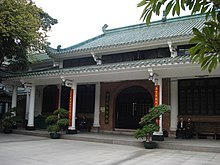Huaisheng Mosque
| Huaisheng Mosque | |
|---|---|
 The Huaisheng Mosque is one of the oldest Mosques in the world, traditionally said to have been first built by Muhammad's uncle, Sa`d ibn Abi Waqqas | |
| Religion | |
| Affiliation | Islam |
| District | Guangzhou City |
| Province | Guangdong |
| Region | China |
| Ecclesiastical or organizational status | Mosque |
| Location | |
| Location | |
| Geographic coordinates | 23°7′31.38″N 113°15′12.91″E / 23.1253833°N 113.2535861°E |
| Architecture | |
| Architect(s) | ... |
| Type | Mosque |
| Completed | ... |
| Specifications | |
| Capacity | ... |
| Minaret(s) | .. |
| Huaisheng Mosque | |||||||||||||||
|---|---|---|---|---|---|---|---|---|---|---|---|---|---|---|---|
| Traditional Chinese | 懷聖寺 | ||||||||||||||
| Simplified Chinese | 怀圣寺 | ||||||||||||||
| |||||||||||||||
| Lighthouse Mosque | |||||||||||||||
| Chinese | 光塔寺 | ||||||||||||||
| |||||||||||||||
The Huaisheng Mosque, also known as the Lighthouse Mosque, is the main mosque of Guangzhou. Rebuilt many times over its history, it is traditionally thought to have been originally built over 1,300 years ago,[1] which would make it one of the oldest mosques in the world. It was named in memory of Prophet Muhammad.
The most unusual (in the Chinese context) feature of the mosque is its "calling tower" (minaret). The round tower is 36 meters tall with a pointed tip.[2] The minaret may have served as a beacon for boats, which may explain its name (Guangta, i.e. literally "Tower of Light"). Guangta may also be translated as "Smooth Tower", referring to the unadorned surface of the minaret. From the tower, the mosque itself got its alternative name (Guangta Si, i.e. literally either "Smooth Tower Mosque" or "Lighthouse Mosque").[2] Somewhat similar "minimalist" minarets can be seen outside of China, e.g. at the Khan's Mosque in Russia's Kasimov.
The other name, Huaisheng Mosque (Huaisheng Si), means "Cherishing the Sacred" or "Cherishing the Sage", presumably referring to Prophet Muhammad.[2] This name has been Romanized in various ways, such as Hwai Sun Su Mosque, Huai-Sheng Mosque, Huai-Shang Mosque, and Huai-Shang Si Mosque. The mosque is also referred to as the Great Mosque of Canton, and as Ying Tong Mosque.
History

Old Chinese Muslim manuscripts state that the mosque was built by Sa`d ibn Abi Waqqas who was an uncle of Prophet Muhammad, and supposedly came on his first Muslim mission to China in the 650s.[3] Although modern secular scholars don't find any historical evidence that Sa`d ibn Abi Waqqas actually visited China,[4] they agree that the first Muslims must have arrived to China within the 7th century,[4] and that the major trade centers, such as Guangzhou, Quanzhou, and Yangzhou probably already had their first mosques built during the Tang Dynasty, even though no reliable sources attesting to their actual existence has been found so far.[3][5]
It is certain that the mosque existed during the Tang Dynasty, or in the early years of the Song Dynasty. The mosque was rebuilt in 1350 then again in 1695 after being destroyed in a fire. The Huaisheng Light Tower or minaret was built at an earlier period.[6]
See also
- Islam in China
- List of famous mosques
- Timeline of Islamic history
- Islamic architecture
- Islamic art
- List of mosques
References
- ^ Great Mosque of Guangzhou at archnet.org
- ^ a b c Steinhardt, Nancy Shatzman (2008), "China's Earliest Mosques", Journal of the Society of Architectural Historians, 67 (3): 335
{{citation}}: Unknown parameter|month=ignored (help) JSTOR 10.1525/jsah.2008.67.3.330 - ^ a b Lipman, Jonathan Neaman (1997). Familiar strangers: a history of Muslims in Northwest China. University of Washington Press. p. 29. ISBN 962-209-468-6.
- ^ a b Lipman, p. 25
- ^ J. Lipman (p. 29) notes that according to Donald Leslie's detailed analysis of both inscriptions in China and West Asian manuscripts, the oldest reliable dates to mosque constructions in China pertain to the Song Dynasty. His source is: Leslie, Donald (1986). Islam in traditional China: a short history to 1800. Canberra College of Advanced Education. pp. 42–46.
- ^ Great Mosque of Guangzhou
